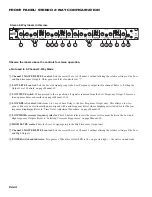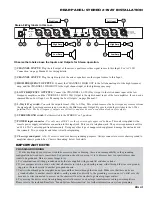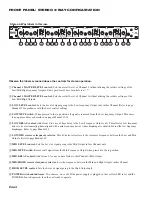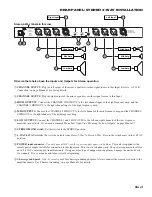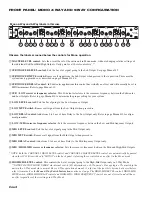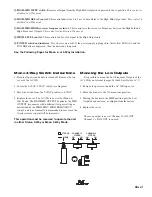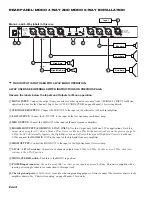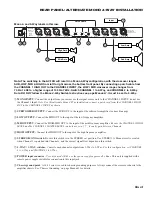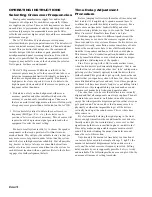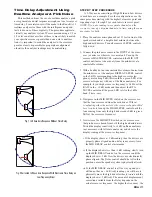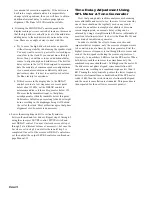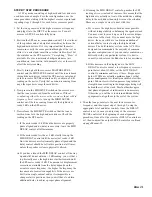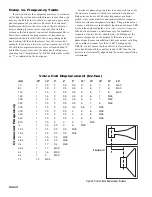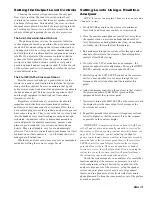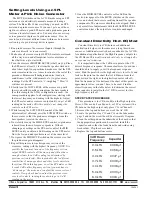
Manual-13
STEP BY STEP PROCEDURE
A 3-Way mode consisting of high, mid and low drivers is
used here as an example. For other configurations, use the
same procedure starting with the highest crossover point and
repeating steps 2 through 5 for each lower crossover point.
1. Set the tone generator to the highest crossover frequency
and plug it into the INPUT of the crossover. Turn all
crossover LEVEL controls fully down.
2. Position the SPL meter (microphone) about 15 feet in front
of the speakers and at a height about midway between the
high and mid drivers. It is very important that the meter
remain in exactly the same position throughout the test, so
affix it to a mic stand, small tree or other stable object. Set
the switches on the SPL meter to “C-weighting”, “Slow” if
available. Be sure to minimize background noise (air
conditioners, fans, traffic, wild animals, etc.) as these will
effect the meter reading.
3. Slowly turn up both the crossover MASTER LEVEL
control and the MID LEVEL control until the tone is heard
through the mid driver. Adjust the SPL meter control and/
or the crossover LEVEL controls until you obtain a 0 dB
reading on the meter. Verify that no sound is coming from
any other speakers except the mid driver.
4. Now press in the MID MUTE switch on the crossover so
that the tone is removed from the mid driver.
Without
re-adjusting either the meter or the crossover Input or Mid
frequency Level controls,
turn up the HIGH LEVEL
control until the tone coming from only the high driver
reads 0 dB on the SPL meter.
5. Now release the MID MUTE switch so that the tone is
emitted from
both
the high and mid drivers. Check the
reading on the SPL meter:
i. If the meter reads +3 dB, then the drivers are properly
phase aligned and no delay is necessary; leave the MID
DELAY control at full minimum.
ii. If the meter reads
less
than +3 dB, slowly turn up the
MID DELAY control until the meter just reads +3 dB.
Now the drivers are electronically phase aligned and the
delay control should be left in this position at all times,
unless the speaker system is physically altered.
iii. If you have turned the MID DELAY control all the way
up and still do not obtain a +3 dB reading, you will have
to physically move the high driver farther forward until
the SPL meter reads +3 dB. The amount of displacement
corrections available from the delay depends on the
actual crossover frequency: the higher the frequency the
less amount of correction capability. If the drivers are
built into a single cabinet and/or it is impossible to
change relative positions, then you will have to obtain
additional delay to achieve proper phase alignment.
iv. If turning the MID DELAY control up makes the SPL
reading
decrease
instead of increase, this means that the
high driver is actually in
front
of the mid driver; adding
delay to the mid driver then only worsens the situation.
There are a couple of ways to deal with this:
a. Try to move the high driver back as far as possible
without losing stability in balancing the speaker stack.
You may want to raise it up as well to restore disper-
sion close to the stack. If you cannot move the high
driver, then you will have to obtain an additional
external delay source to align the high and mid
drivers. The built-in delay system in the AC 23B is
designed to accommodate the majority of common
speaker configurations; if you encounter confusion or
difficulty with your particular system, it is best to
consult your dealer or the Rane factory for assistance.
b. If this decrease in the display due to the LOW
DELAY control occurs at a low frequency crossover
point below about 150 Hz, set the LOW DELAY
control to minimum and leave it there. Frequencies
below 150 Hz are actually omnidirectional, so that
phase misalignment is virtually inaudible below this
point. Subwoofers will often possess long folded or
straight horns, resulting in the diaphragm being well
behind the rest of the stack. Most authorities agree
that phase alignment of subwoofers is unnecessary.
Otherwise you will have to obtain additional delay
equipment to align these to the rest of the system.
6. Tune the tone generator to the next lower crossover
frequency and then repeat steps 2 through 5, using the
appropriate level and delay controls. Once the DELAY
control is set, you may re-adjust any of the crossover
LEVEL controls at the beginning of each alignment
procedure. Once all of the crossover DELAY controls are
set, then re-adjust the output LEVEL controls as outlined
on page Manual-15.


